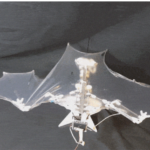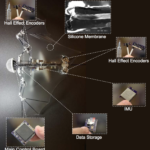Bat Robot Offers Safety and Maneuverability in Bioinspired Design
Bat wings are fundamentally different from bird wings. The underlying structure of a bat’s wing is made up of “a metamorphic musculoskeletal system that has more than 40 degrees of freedom” and bones that actively deform during every wing beat. The wing surface itself is an “anisotropic wing membrane skin with adjustable stiffness.” The researchers cut down the number of DoFs to give (the shoulder movement, elbow movement, wrist bending, and side-to-side movement of the legs and tail) which still allows the robot to replicate over 57% of bat flight kinematics. The wing itself is made of a flexible silicone membrane which is just 56 micrometers thick. Eventually, B2 (or bat robots like it) could be used in situations where flight in close proximity to obstacles is necessary since wings are much more forgiving to collisions than rotors are. The researchers are specifically interested in construction site inspection, although they also talked about such robotic research project staples as disaster relief and surveillance.
Learn about our two Decals!
 Click here to find out more about our Fall Bioinspired Design Decal and our Spring Bioinspired Design in Action Decal – ALL MAJORS are welcome.
Click here to find out more about our Fall Bioinspired Design Decal and our Spring Bioinspired Design in Action Decal – ALL MAJORS are welcome.Berkeley BioDesign Community
 Click here to learn about the BioD: Bio-Inspired Design @ Berkeley student organization or here to signup for more info.
Click here to learn about the BioD: Bio-Inspired Design @ Berkeley student organization or here to signup for more info.Search
Student Login





I imagine that the neurological circuits underlying these processes are governed by both 2d spacing maps with their brains as…
to reduce the impact of car accidents, it may be possible to study the force diverting physics of cockroaches to…
you see this type of head-bobbing stability in many avian creatures related to pigeons like chickens. the head ability to…
not like they taught horses how to run! this is an example of convergent evolution where both sea creatures and…
The brain functions in a similar way with neuronal connections. our brains are able to utilize the multiplicity of connections…